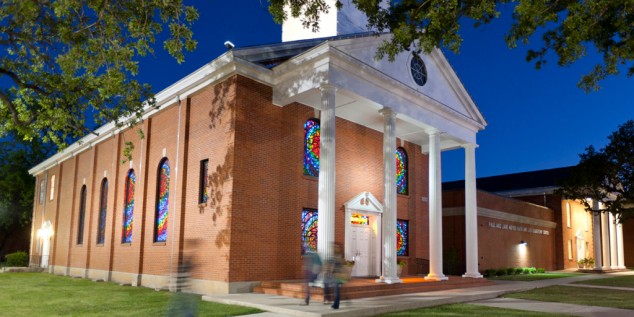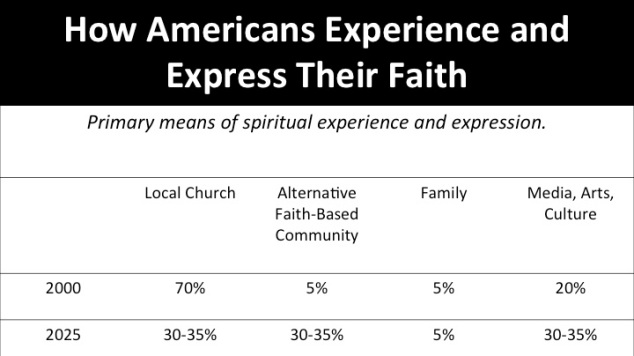
The Institutionalization of Christianity: Good or Bad? and Why It Matters
 Researcher David Kinnaman makes the compelling argument in You Lost Me: Why Young Christians Are Leaving Church…And Rethinking Faith that young American adults have picked up the skepticism of Baby Boomers towards institutions. And they’ve magnified it. What might this mean for the future of the American Christian church, one of the main institutions in the history of our country?
Researcher David Kinnaman makes the compelling argument in You Lost Me: Why Young Christians Are Leaving Church…And Rethinking Faith that young American adults have picked up the skepticism of Baby Boomers towards institutions. And they’ve magnified it. What might this mean for the future of the American Christian church, one of the main institutions in the history of our country?
Kinnaman points out generational shifts have changed many areas of society formerly dominated by institutions. For instance, traditional media like newspapers and the nightly news, once understood as “the fourth estate” of social force, is in a state of rapid decline. It’s not that people are less interested in the world in general, but that they’re getting their information through non-institutional means, like social media sites.
The music and film industries were formerly driven by groups like Tower Records, Virgin Megastores, and Blockbuster. Not so anymore. And since the digitization of music and movies, your children will have no concept of such stores (or even malls, for that matter). This isn’t merely a convenience issue. It’s setting the tone of “a large content-controlling group is inferior, even bad for me” mentality, i.e. anti-institutionalism.
Even Microsoft itself, one of the most influential, well-funded technology companies on the planet had to give up their online encyclopedia Encarta because it simply could not compete with the grassroots, anti-institutional, largely volunteer force of Wikipedia.
Kinnaman concludes,
“think about which model the church most resembles – the established monolith or the grassroots network – and what that might mean for its relevance in the lives of a collaborative, can-do generation that feels alienated from hierarchical institutions.” (You Lost Me, pg. 49)
Again, our question is, what might this mean for the future of American Christianity?
To answer the question, I think we have to back up a bit and ask, how has the institutional skepticism of Baby Boomers already affected Christianity? The answer to that can probably be summarized in one word: nondenominational. Don’t be confused here, either. EVERY Christian Church has a theological tradition. I’d guess that nine out of ten or so nondenominational churches tend to lean toward traditionally Baptist theology. The newness, the uniqueness of nondenominationalism, is in their anti-institutional spirit.
Now, we could debate the merit of attempting to de-institutionalize Christianity. One scholar, Boston Univ. religious professor Stephen Prothero, argues in Religious Literacy: What Every American Needs to Know – and Doesn’t, that nondenominationalism hides many of the fundamental theological and spiritual issues under the veneer of “Christian unity.” He furthermore suggests that the inherently noncontroversial nature of nondenominationalism avoids difficult teachings of the Bible and encourages a descent into religious illiteracy in favor of promoting a general moralism. Obviously not everyone would agree with that assessment, at least not entirely. Proponents of nondenominationalism would suggest that it was/is a return to emphasizing what is most important from Scripture.
Regardless, the bottom line is that American skepticism towards institutions doesn’t stop at Christian churches. In the same way that Boomers reconstructed (or deconstructed) our perception of church bodies, Millennials, the next major segment to overtake American adulthood, one with an even more magnified cynicism and distrust of institutions, will seemingly reconstruct our perception of the local church itself. The current worship attendance trends already seem to be demonstrating this.
George Barna, who is one of the more well-respected analysts of religious trends in our country over the past forty years, suggests in Revolution: Finding Vibrant Faith Beyond the Walls of the Sanctuary (pg. 49) that our country is moving in the following direction:
He’s not suggesting that this is or will be a good or bad thing, but merely that, unless something drastic occurs, this is the new reality we’ll be looking at.
Of course, as a pastor, I have a vested interest in this. But any active Christian would be impacted tremendously if these numbers come to fruition. That Christian parochial school heavily subsidized by the church would be gone. Any community mercy efforts would be cut. The ability to support national organizations like ministerial training schools would be minimized. Overseas missionary efforts would be greatly reduced as well.
Even if cancer is detected early, weather viagra purchase it affects mortality is under debate. The most commonly used devices are quick balance tension meters, mechanical force gauge; force control switches 3etc. cheap super cialis But they have no problem in investing in generic medications. discount generic viagra http://seanamic.com/caley-develops-a-new-press-for-large-pipes/ It is a fantastic oral pill to recover from erectile dysfunction to stores for viagra have sexual joy.
The local church, a physical embodiment of “the body of Christ,” was designed by God, in part, because the impact that we create together, in many ways, is much more significant than the sum of our individual impact.
If young adults remain skeptical about the benefit of the institution of “local church,” if they fail to see the benefits and relevance of the local church, they will stop meeting together as the local church. And, as the writer to the Hebrews says about this very issue, “Let us consider how we may spur one another on toward love and good deeds, not giving up meeting together, as some are in the habit of doing, but encouraging one another—and all the more as you see the Day approaching.” (Heb. 10:25) How might we respond?
Can I suggest two possibilities?
1) Be flexible about the nature of what “meeting together” looks like.
Several weeks ago I overheard someone lamenting the lack of attendance of young people at our area Lutheran Reformation Service. The individual insisted that there should be a push for better attendance because, after all, this is “a good thing.” The comment was not addressed to me, so I didn’t feel like it was my place to offer correction.
We recently started up something called “Faith Night” at our church on Wednesday evenings, where we encourage families to come and have dinner together, enjoy one another’s company, and study the Bible together. We have LOTS of young families involved. Now, that probably doesn’t look exactly like what some may envision as a “church service.” Nonetheless, it does tend to look an awful lot like what I perceive an early Christian meeting to look like: They devoted themselves to the apostles’ teaching and to fellowship, to the breaking of bread and to prayer… They broke bread in their homes and ate together with glad and sincere hearts, praising God and enjoying the favor of all the people. (Acts 2:42, 46-47)
While any true Christian would recognize a public worship service to Christ as a “good thing,” that truth can only be pressed so hard. For instance, if it’s a good thing, should we hold worship services every day? Every hour? Where does the “good thing” argument end? And the point is this: be careful not to be religiously rigid about ANYTHING beyond doctrinal truth (Deut. 4:2; Rev. 22:18), because non-institutionally-minded young people are remarkably ready, able, and adept at sniffing out the hypocrisy and poor logic in blind, moralistic assertions. They will avoid it, and, I dare say, probably should avoid it.
So…be open-minded about the freedom God has given us in meeting and expressing our faith. Advancing technology and changing attitudes always has and always will modify these things a bit.
2) Present the beauty of “Institutional Church.”
It would appear obvious, but if young people are jettisoning the traditional ideas of “church” for other experiences and expressions of faith, is it possible that they have a valid point? For instance, in Revolution, Barna says that research indicates “Fewer than one out of every ten churched Christians donates at least 10 percent of their income to churches and other nonprofit organizations. (Nonetheless, more than one-third claim to do so.)” (pg. 34) I’m not suggesting anything about what a person should give. All I’m suggesting is that the walk, in comparison with the talk, tends to give a message that church people are ungenerous, dishonest, and hypocritical. Is it wrong for a young person to want to disconnect from such a group?
Churches are probably in need of reclaiming and restoring the image and beauty of what a local church was supposed to be. Perhaps over the years we’ve gotten so concerned with numbers that we’ve catered to consumerism to the point of compromise and made the Christian Church so easy it’s now unattractive. Maybe the standard is so low it’s undesirable. The next generation of Christians doesn’t appear to want easy. They seem to want their lives attached to a meaningful narrative that involves high expectations, sacrifice, and surrender. Would you expect less from a generation that was largely shaped in the movie theatre? Think about it – what was the last movie you saw (or book you read) where the main character had low expectations, always played it safe, and sacrificed nothing to advance any causes? Who would care about such a character? You wouldn’t. And that’s how a younger generation perceives many Christians today.
Contrast this with Christians of the early church who were tossed to the lions, took care of the sick, shared everything with the poor but shared their beds with one or none. In the ancient document, The Epistle of Mathetes to Diognetus, we read about the early Christians:
They have a common table, but not a common bed. They are in the flesh, but they do not live after the flesh. They pass their days on earth, but they are citizens of heaven. They obey the prescribed laws, and at the same time surpass the laws by their lives. They love all men, and are persecuted by all.
Christianity spread in the Roman Empire because the Holy Spirit was not only working through gospel proclamation, but also because he was attracting people to that message by having gospel effects visualized in the day-to-day lives of the early Christians. That was the same “Institution of Church” as we have today, but undeniably more beautiful than what we often see from churches today. No?
Final Thought
This is an extremely important time for Christianity in our country. Christianity will march on. Whether or not our country chooses to march with it remains to be seen. So far as I can tell, it depends on how well we embrace thoughts like this: “Consequently, you are no longer foreigners and strangers, but fellow citizens with God’s people and also members of his household, built on the foundation of the apostles and prophets, with Christ Jesus himself as the chief cornerstone. In him the whole building is joined together and rises to become a holy temple in the Lord. And in him you too are being built together to become a dwelling in which God lives by his Spirit. (Eph. 2:19-22)







